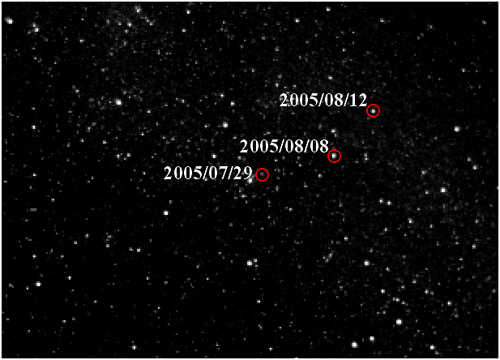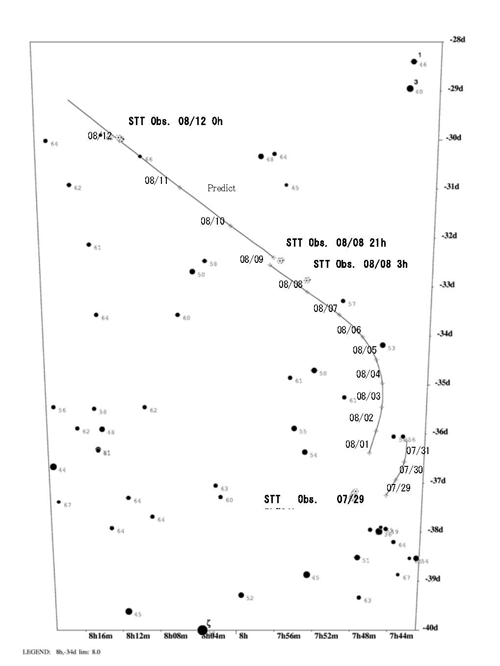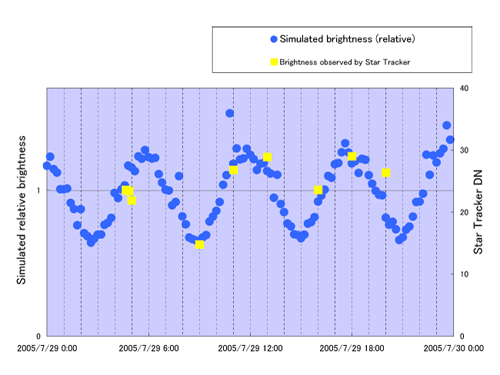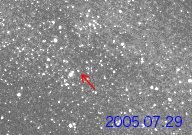Skip to comments.
Hayabusa performed the Star Tracker imaging of Itokawa
JAXA ^
| August 15, 2005
Posted on 08/26/2005 1:49:21 AM PDT by snowsislander
For almost two years and three months after the launch in May of 2003, Hayabusa spacecraft has traveled a long journey by way of Earth gravity assist in May of 2004, and will make a worldÕs first low thrust rendezvous with a near-Earth asteroid Itokawa next month.
Hayabusa performed the Star Tracker imaging of Itokawa on July 29-30, August 8-9 and August 12. Totally, 24 images were taken and the hybrid navigation combining both radio and optical measurement was performed and the results came out enough well to guide the spacecraft making a final approach to the object. The optical navigation at very slow approach speed under ion engines propulsion is what Hayabusa has demonstrated for the first time. The exposure of Optical Navigation Camera (ONC), a high resolution imager, is also planned one or two weeks later.
Hayabusa carries three reaction wheels aboard. There was an incident on x-axis wheel, whose friction exceeded a driving torque on July 31 and stopped. However, the spacecraft is designed equipped with Double-Reaction-Wheel (DRW) mode software, and taking the advantage of it, the spacecraft resumed the attitude stability and has been operated normally. The project team is confident in accomplishing a series of scientific observation including sample collection scheduled during the proximity phase.
The spacecraft is, as of August 12th, at about 35,000 kilometer at the very slow approach speed of 38 meters per second. This is peculiar to the low thrust rendezvous that has not ever been experienced. The spacecraft will turn off the ion engines at the distance of 3,500 km to the object leaving intentional residual approach speed of 10 meters per second that is scheduled decelerated via Reaction Control System aboard. And in the middle of September, Hayabusa comes to still with respect to Itokawa at the distance of 20 km, Gate Position.
(This release is coordinated with NASA.)
1.Image of Asteroid Itokawa taken by HAYABUSA's Star Tracker
2.Predicted position and observed position of Asteroid Itokawa
3.Brightness of Asteroid Itokawa
4.The locus of Asteroid Itokawa
|
|
1.Image of Asteroid Itokawa taken by HAYABUSA's Star Tracker
 |
This shows the object conceived Itokawa moves amid stars and strongly suggests this is not a star but a kind of planet.
The constellation over which the object is exposed is the Puppis between the Canis Major (Great Dog) and the Carina.
Itokawa may not be seen toward that direction from Earth, but seen via radio toward the Sun, nearest of which Itokawa should be together with Hayabusa spacecraft. Itokawa seen from Hayabusa has increased quite rapidly its brightness up to the magnitude four. |
|
|
2.Predicted position and observed position of Asteroid Itokawa

|
|
|
It draws loci of the Itokawa direction from Hayabusa. Where Itokawa was exposed is plotted against the star map. Any object whose orbit parameters are different from those of Itokawa should never have been photographed. This simply indicates what is actually exposed is sure to be the object we have sought so far, which is our target destination, Itokawa.
Whenever the optical navigation is performed, the relative trajectory has been updated and this process results in the loci corrected, so that the Itokawa direction should coincide with what was predicted. The optical measurements were combined with the radio data obtained on the ground. This sophisticated process is so called a hybrid navigation technique. These results conclude we could successfully complete the hybrid navigation task. The final portion of the locus was not significantly corrected and this implies our predict has already been enough accurate to guide the spacecraft to Itokawa. |
|
|
3.Brightness of Asteroid Itokawa
 |
|
|
The brightness intensity of the object conceived Itokawa is plotted along with exposure time. The predict curve of it derives from the shape
and rotation parameters determined last year, when Itokawa flew close by the Earth. It is of great importance to notice that this object's light curve shows a beautiful fit for the predict. This indirectly proves that the object is Itokawa. |
|
|
4.The locus of Asteroid Itokawa

|
TOPICS: Foreign Affairs; Japan
KEYWORDS: asteroid; asteroiditokawa; hayabusa; itokawa; japan; space
To: snowsislander


HAYABUSA?
2
posted on
08/26/2005 1:58:12 AM PDT
by
CarrotAndStick
(The articles posted by me needn't necessarily reflect my opinion.)
To: CarrotAndStick
 |
 |
 |
 |
PARAM name="quality" value="high"> |
 |
  |
HAYABUSA is currently speeding towards Itokawa. It is scheduled to reach its destination and collect samples in the summer of 2005, returning to Earth a year and a half later, in 2007, with the first-ever samples collected from an asteroid.

|
          |
 |
 |
 |

 HAYABUSA's return trip from Earth to Itokawa is 2 billion kilometres long. Needless to say, such a long journey requires a large amount of fuel. HAYABUSA is the first long-distance interplanetary probe to use an ion engine as its main propulsion device. HAYABUSA's return trip from Earth to Itokawa is 2 billion kilometres long. Needless to say, such a long journey requires a large amount of fuel. HAYABUSA is the first long-distance interplanetary probe to use an ion engine as its main propulsion device.
Traditionally, propulsion occurs when gas is emitted at high speed. Until now, the main form of propulsion has consisted of super-heated gases created by burning fuel with an oxidant. An ion engine, in contrast, gets thrust from ionized gas accelerated by electricity. Therefore, it can accelerate much faster than by traditional propulsion, and only requires a tenth of the fuel.
|
 |

HAYABUSA will approach Itokawa 0.3 billion kilometres from Earth. At this distance, even light takes about 17 minutes to travel, so if HAYABUSA needed an emergency instruction from Earth, it would not reach the probe in time. Therefore, HAYABUSA is designed to pilot itself: to use the on-board camera and laser to read the asteroid's geography and judge when to approach it and where to land. |
 |

It is impossible to land and stick to an asteroid with very low gravity, so the contact lasts only one second. During this brief contact, HAYABUSA will fire a 5-gram metal ball at the surface, at a speed of 300 metres per second, and collect pieces stirred up by the impact. This is a revolutionary method for dealing with an asteroid with low gravity.
|
 |
|
 |

The robot Minerva will detach from HAYABUSA, land on Itokawa, and survey it while moving around its surface.
Moving around on wheels works only when gravity is present, so a probe with wheels is of no use on Itokawa. Minerva travels by leaping, using its own momentum by accelerating a weight inside itself. This is an entirely new idea.
Minerva will use its camera to take images of Itokawa's surface and also read its temperature. |
|
 |

The capsule containing samples collected from Itokawa will detach from HAYABUSA at a distance from Earth equal to half the distance to the Moon, and plunge into Earth's atmosphere.
Until now, similar capsules or probes have entered the Earth's orbit first, and then re-entered the atmosphere once their speed was reduced.
These capsules used different kinds of fuel and propulsion devices than HAYABUSA, which, because of its smaller and lighter body, can re-enter the atmosphere directly.
The capsule will enter the atmosphere at a speed of 12 kilometres per second, heating up to 3000°C. To keep it from burning up, a new material was developed specially for it.
The capsule is scheduled to land in the Australian desert.
|
 |
 |
 |
 |
 |
 |

|
 |
To: snowsislander
4
posted on
08/26/2005 4:20:39 AM PDT
by
RadioAstronomer
(Senior member of Darwin Central)

In this photo released by Japan Aerospace Exploration Agency (JAXA), the part of asteroid Itokawa is seen with the shadow of probe Hayabusa on top right Saturday, Nov. 12, 2005. The Japan's space agency suffered another glitch in its mission to collect surface samples from asteroid Itokawa and retrun to Earth when a can-sized robot lander apparently became lost in space while attempting a practice landing. The rehearsal landing followed an earlier attempt that was aborted due to mechanical trouble, but the space agency said it will go ahead with actual landings on the potato-shaped asteroid Itokawa on Nov. 19 and Nov. 25. (AP Photo/Japan Aerospace Exploration Agency, HO)
5
posted on
11/13/2005 12:06:59 PM PST
by
NormsRevenge
(Semper Fi ... Monthly Donor spoken Here. Go to ... https://secure.freerepublic.com/donate/)
To: snowsislander
Interesting mission. Success here could trigger a large increase in the interest of Japan in space exploration.
6
posted on
11/13/2005 12:11:08 PM PST
by
RightWhale
(Repeal the law of the excluded middle)
Disclaimer:
Opinions posted on Free Republic are those of the individual
posters and do not necessarily represent the opinion of Free Republic or its
management. All materials posted herein are protected by copyright law and the
exemption for fair use of copyrighted works.
FreeRepublic.com is powered by software copyright 2000-2008 John Robinson

















